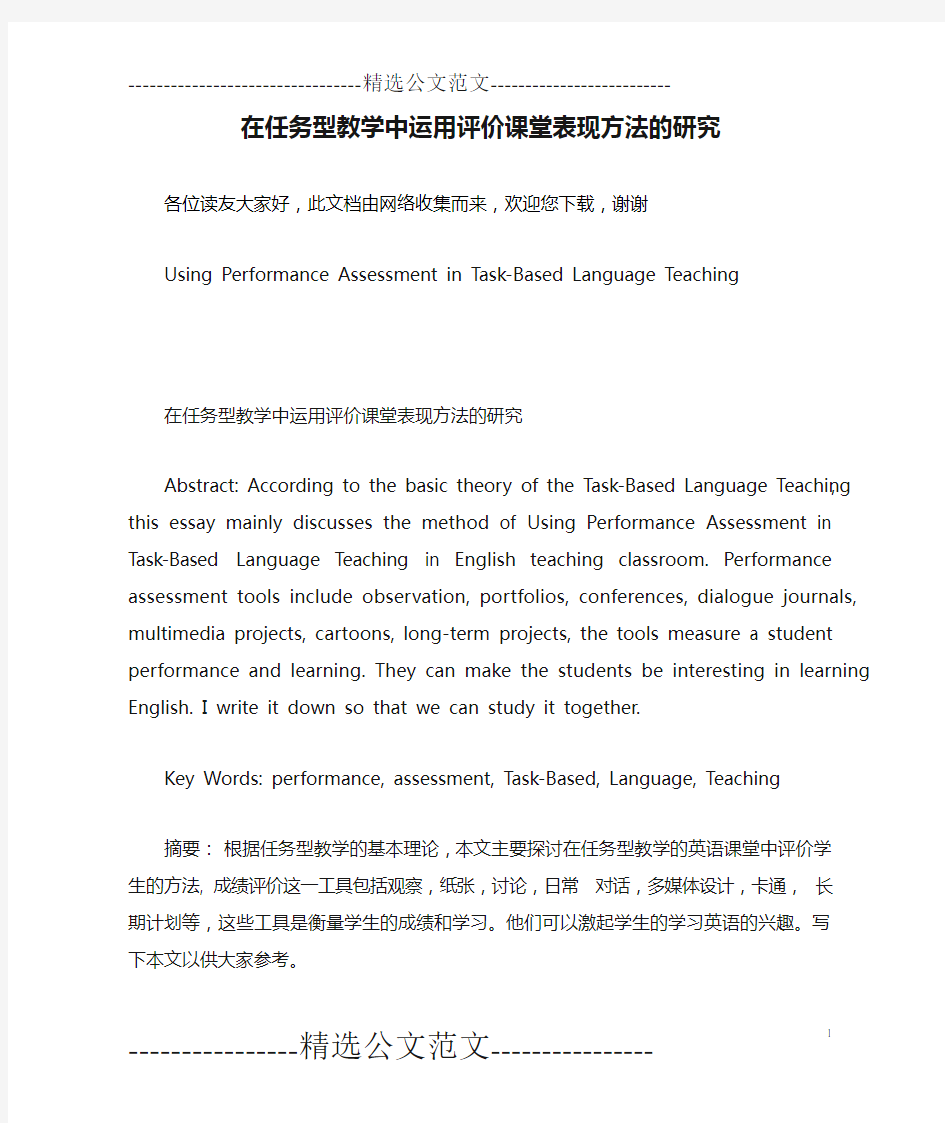在任务型教学中运用评价课堂表现方法的研究


在任务型教学中运用评价课堂表现方法的研究
各位读友大家好,此文档由网络收集而来,欢迎您下载,谢谢Using Performance Assessment in Task-Based Language Teaching
在任务型教学中运用评价课堂表现方法的研究
Abstract: According to the basic theory of the Task-Based Language Teaching,this essay mainly discusses the method of Using Performance Assessment in Task-Based Language Teaching in English teaching classroom. Performance assessment tools include observation, portfolios, conferences, dialogue journals, multimedia projects, cartoons, long-term
projects, the tools measure a student performance and learning. They can make the students be interesting in learning English. I write it down so that we can study it together.
Key Words: performance, assessment, Task-Based, Language, Teaching
摘要:根据任务型教学的基本理论,本文主要探讨在任务型教学的英语课堂中评价学生的方法, 成绩评价这一工具包括观察,纸张,讨论,日常对话,多媒体设计,卡通,长期计划等,这些工具是衡量学生的成绩和学习。他们可以激起学生的学习英语的兴趣。写下本文以供大家参考。
关键词:表现,评价,任务型,教学Ⅰ. Introduction
Are you familiar with the following”
1. Is it true or false?
2. Is it answer a. b, c. d (or all of the above )?
3. Can you match the definition of the
vocabulary word to the word listed beside? Most teachers’answers are positive for they are the questions we often see in our examination papers. We’d categorize these questions into the Traditional Assessment type, which is to assess a child’s direct recall of the information. In our English language teaching (ELT) assessment reform, we advocate Performance Assessment, which is to 1) meet the needs of children who learn in a variety of modalities; 2) assess a child’s ability to solve problems, process information, and work in real-world settings.
ⅡWorking Definition for Performance Assessment
What distinguishes performance assessment from other types of assessments? According to Cooper (1997), performance assessments are tasks which require children to demonstrate their knowledge and skills in response to
authentic activities. So in performance assessment, it appears to be that students must perform tasks, and the tasks should be as authentic as possible. Success or failure in the outcome of the tasks, because they are performances, must usually be rated by qualified teachers. The teachers observe the behavior of the students or examine the product that is reflective of that behavior, and apply clearly articulated performance criteria in order to make a judgment regarding the level of proficiency demonstrated by the students (Pierce & O’Malley, 1992). What we use in performance assessments in English classrooms are posters, reports, tasks and projects, or the creation of plays (Cooper, 1997). By making English posters students demonstrate their creativity and imagination in language learning; English reports show students’reading and writing skills; tasks and projects show
students’abilities to integrate content knowledge across subject areas (interdisciplinary skills and inquiry learning skills); and in the creation of plays students perform what they have learned. In performance assessments students plan, make decisions, apply (their content knowledge), communicate, and co-operate.
The key characteristics for consideration in designing second language performance assessments are (a) collaboration: Do students share in the learning process? (b) context: Are the objectives taught in meaningful tasks? (c) real-word tasks: Are they relevant to our students’lives now and later? (d) authentic standards: Do they measure what we are really trying to measure?
Ⅲ. Performance assessment and Task-Based Approaches
Second language performance assessment
and task-based approaches to language teaching and assessment share a great deal of theoretical and practical common ground. Performance assessments will typically be based on tasks, which will be judged by raters on the basis of some forms of rating scale. Student performance exists across tasks and content areas and observations must be made carefully and frequently by the teacher.
Tasking students perform should be based on needs analysis (including student input) in terms of rating criteria, content and contexts. They should be as authentic as possible with the goal of measuring real-world activities. Sometimes they have collaborative elements that stimulate communicative interactions. They should be contextual and complex. They involve integrated skills with content and are appropriate in terms of number, timing, and frequency of assessment. They are
generally non-in-trusive aligned with the daily actions in the language classroom (Norris et al., 1998). Task raters should be appropriate in terms of number raters, overall expertise, and familiarity and training in use of the scale. The rating scale should be based on appropriate categories of language learning and development, breadth of information regarding learner performance abilities, and standards that are both authentic and clear to students. Tasks are to enhance the reliability; performance assessments should be combined with other methods for gathering information (for instance, self-assessments portfolios, conferences, classroom behaviors, and so forth).
Ⅳ. Definitions of Tasks
There are various definitions of tasks. Here we list a few:
(1985:89); A task is “a piece of work undertaken for oneself or for others, freely
or for some reward. Thus, examples of tasks include painting a fence, dressing a child, filling out a form … , and helping someone across a road. In other words, by ‘task’is meant the hundred and one things people do in everyday life, at work, at play, a nd in between.”
2. Richards, Platt and Weber (1986:289):
A task is “ an activity or action which is carried out as the result of processing or understanding language ( as a response)” .
3. Nunan (1989:10): A communicative task is “ a piece of classroom work which involves learners in comprehending, manipulating, producing or interacting in the target language while their attention is principally focused on meaning rather than form. The task should also have a sense of completeness, being able to stand alone as a communicative act in its own right.”(1995): A task is “an activity in which meaning is primary; there is some sort of
relationship to the real world; task completion has some priority; and the assessme[1] [2] [3] [4] 下一页
各位读友大家好,此文档由网络收集而来,欢迎您下载,谢谢
